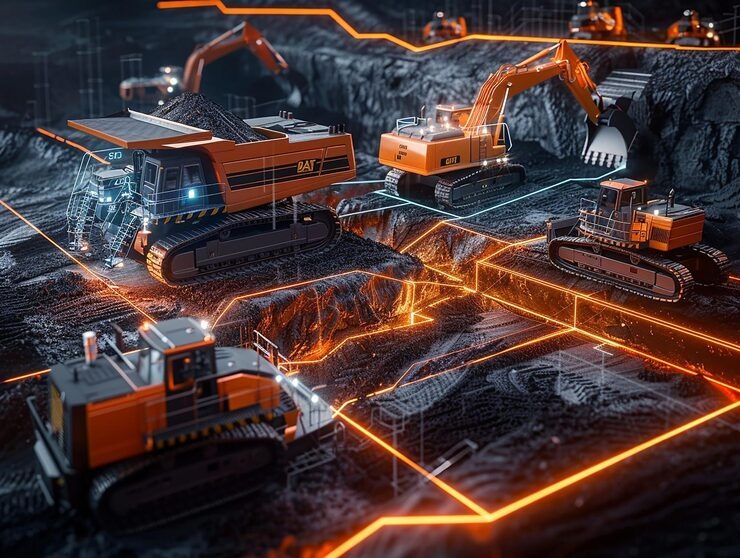The Internet of Things (IoT) has emerged as a transformative technology in lots of industries, and mining is no exception. Mining operations are historically aid-extensive, excessive-threat, and depending on complex deliver chains. By embedding IoT-enabled sensors, clever gadgets, and related machinery into mining infrastructure, agencies benefit actual-time visibility, predictive competencies, and operational efficiency.
Importance
In mining, IoT has significant significance for many stakeholders from mining companies to authorities and communities in mining:

Security Reforms:
Portable IoT equipment monitoring activists notify health and emergency mentors.
Future maintenance:
Connected sensors detect machine errors before breakdown, reducing shutdowns.
Energy optimization:
Smart systems track power consumption to reduce energy waste.
Environmental monitoring:
IoT equipment measures air quality, water use and emissions, which helps companies to follow the rules.
Operating efficiency:
Automatic fleet reduces control and connected logistics delays and increases production.
Supply chain Transparency:
IoT-activated tracking ensures that materials are monitored from extraction to distribution.
In today's competitive market, mining companies that use IoT not only achieve efficiency, but also increase stability and social chairs.
Recent Updates
The year 2023-2024 has seen many advances in adopting IoT in mining:
Digital twins:
mining companies quickly make digital copies of their business for simulation and adaptation of real time (reported at the end of 2023).
5G integration:
Mines in Australia, Canada and South Africa have rolled out private 5G networks to support a large -scale IoT distribution.
Automation growth:
Rio Tinto and BHP announced expanded use of autonomous trucks and drilling systems operated by IoT competition controls.
Sustainability focus:
In 2024, many mining companies began to report ESG Matrix using IoT-based environmental monitoring systems.
AI-driven analysis:
Machine learning models apply to sensor data for quickly smart resource allocation and risk management.
These updates highlight the faster speed of IoT innovation in mining and its role in the design of permanent and efficient operation.
Laws or Policies
IoT in mining is influenced by rules that focus on security, environmental and technology standards:
Professional Security Act:
Many countries require the use of surveillance systems for dangerous environments. IoT units help companies fulfill these security obligations.
Data Protection Regulations:
Since IoT collects large amounts of data, compliance and compliance with cyber security laws, such as GDPR (EU) or CCPA (USA), are necessary.
Environmental policy:
government emissions, water use and mandate to monitor land rehabilitation; The IoT system helps complete compliance.
Mine code:
Countries such as Australia, South Africa and Canada have mining-specific structures that encourage digital changes.
Technology standards:
International bodies promote interoperability standards so that IoT units across sellers originally work in industrial surroundings.
Protecting workers and the environment develops a political framework, and encourages the responsible use of IoT in mining.
Tools and Resources
IoT- A series of focused equipment and resources can support mining companies, researchers and decision makers:
IOT platform for mining:
IBM Maximo, SAP Leonardo and Azure IoT Capable Data Management and Future Catching Analysis.
Remote Sensing Tool:
Drone and IoT competing cameras for inspection and monitoring of the site.
Fleet Management software:
GPS and Telematics Solutions in real time for hall cars and equipment.
Portable safety equipment:
Smart helmets, connected waste and biometric trackers for workers' safety.
Industrials Association:
International Mining and Metals (ICMM) and Mining Association of Canada offer guidelines for IoT adoption.
Educational resources:
Online platforms that offer IoT and mining courses, such as Coursra and EDX.
| Application Area | IoT Role | Example Tools/Technologies |
|---|---|---|
| Worker Safety | Monitor health and environment | Smart helmets, biometric sensors |
| Equipment Management | Predictive maintenance and automation | Vibration sensors, digital twins |
| Energy Efficiency | Optimize energy and fuel usage | Smart grids, IoT energy monitors |
| Environmental Control | Monitor air, water, and emissions | IoT air sensors, water sensors |
| Supply Chain Tracking | Ensure transparency from mine to market | RFID, GPS tracking platforms |
FAQs
What does IoT in the mine work?
IoT in mining refers to the use of connected sensors, equipment and platforms that enable probability monitoring, automation and analysis to improve safety, efficiency and stability.
How does IoT improve the safety of mining?
IoT Wearables workers track in contact with health, location and dangerous conditions. Systems generate notifications in an emergency, ensure rapid response and prevention of accidents.
What role does 5G play in IoT mining applications?
The 5G networks provide high-speed, low-option connection that supports mass IoT systems in mines, enabling reliable data transfer for automation and external operations.
Does IoT have environmental benefits of mining?
Yes, IoT systems monitor air quality, emissions, water use and land effects. This helps companies to follow environmental laws and reduce their organic footprints.
What are the challenges of using IoT in mining?
The challenges include high infrastructure costs, cyber security risk, effective labor shortages and integration with cultural monuments. However, ongoing innovations address these obstacles.
Conclusion
IoT in mining represents a primary shift toward linked, efficient, and sustainable operations. By integrating clever devices, automation, and superior analytics, mining agencies can lessen risks, enhance employee protection, and streamline manufacturing.
The speedy boom of 5G networks, digital twins, and AI-pushed insights similarly strengthens IoT’s function in mining. While regulations make certain compliance with safety, environmental, and facts requirements, companies need to additionally navigate challenges like cybersecurity and staff schooling.
As the mining region maintains to embody IoT, the future points towards smarter, safer, and greener operations that balance productiveness with sustainability.